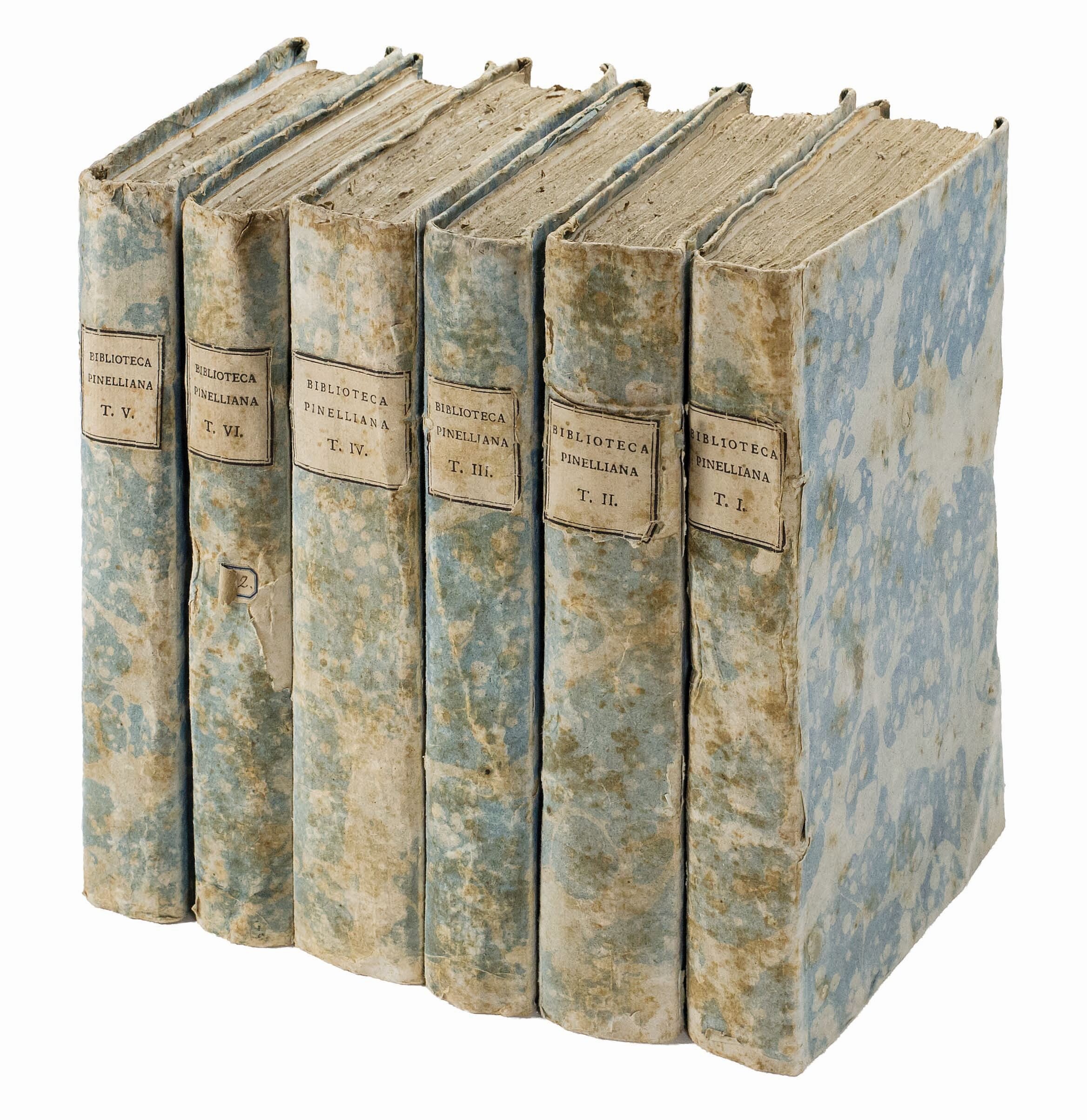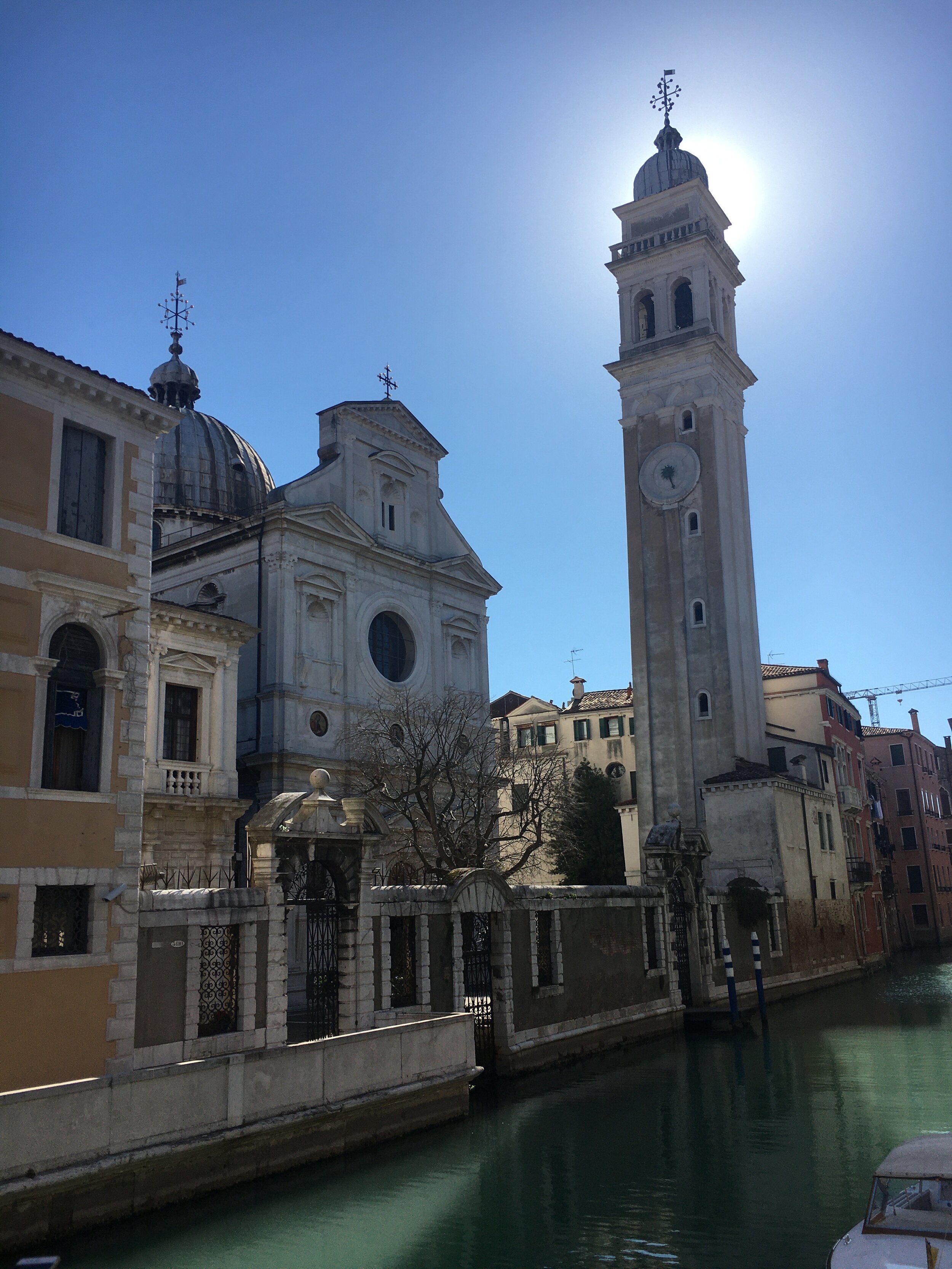"The book-treasures of the far-famed Pinelli Collection": The Bibliotheca Pinelliana and its Catalogue, from Venice to London
We present here a fine, uncut copy, in contemporary marbled boards, of the catalogue of one of the most significant private libraries of eighteenth-century Europe: the magnificent book collection assembled by the Venetian printer and bibliophile Maffeo Pinelli (1735-1785; read the complete description of this copy here).
Maffeo Pinelli was born into a wealthy family, whose members served as the official Ducal printers of the Republic of Venice for almost two centuries.
The first member of the family to be active in the book world was Antonio Pinelli, who established a printing press near the church of Santa Maria Formosa.
Campo Santa Maria Formosa, Venice. November 2020.
Antonio Pinelli soon counted among the leading, and most prolific printers active in Venice. Given the multi-cultural and multi-lingual character of the city, it is not surprising that a significant portion of his production focused on liturgical and vernacular literature for the large Greek community living in the city near the Church of San Giorgio and the Scuola de’ Greci, not far from the seat of the Pinelli Press.
The Rio de’ Greci and the Greek Orthodox Church of San Giorgio, Venice. February 2021.
In 1617, Pinelli was named Stampatore Ducale, i.e. official printer of the Serenissima, responsible for publishing all officially issued documents including regulations, statutes, and decrees dealing with taxations, criminal law, etc. The Pinelli dynasty was active in this capacity for the Venetian Republic until its fall in 1797.
The Pinelli family’s role as official printers of the Republic, along with their production of books for both the internal Greek market and the Orthodox churches of the eastern Mediterranean, provided lucrative business for the Pinelli family, so much so that Maffeo would come to inherit not only a successful printing press, but also two-centuries’ worth of book collecting.
The Pinelli printer’s device generally used for books issued for the Greek market.
Maffeo Pinelli significantly enlarged the family library over the course of his life, acquiring numerous rare volumes from Venetian monasteries and outstanding Venetian patricians. He also always took the opportunity to purchase collections amassed by other bibliophiles en bloc. This is the case of the library owned by the Venetian nobleman Andrea Redetti (1723-1784), which contained an extensive series of editions printed by Aldus Manutius and his heirs. Pinelli was especially interested in Aldine volumes that were printed on vellum and finely illuminated: one of the finest examples of his taste as a collector is the copy of Jacopo Sannazaro’s Arcadia of 1514, now preserved in the Aldine Collection of the John Rylands Library in Manchester.
In addition to the books, Pinelli assembled a valuable collection of coins, medals, prints, statues, and paintings by renowned masters.
Maffeo Pinelli died prematurely in 1785. That same year, his friend Jacopo Morelli (1745-1819), librarian at the Marciana Library, edited a catalogue of his large collection of paintings, the Catalogo di quadri raccolti dal fu Signor Maffeo Pinelli ed ora posti in vendita.
The Catalogo, which was privately published by Pinelli’s stepfather and executor Daniele Zanchi, includes detailed descriptions and measurements (in Venetian feet) of the artworks offered for sale. These were authenticated by the artists Davide Fossati (1708-1795) and Domenico Maggiotto (1713–1794), both members of the Venetian Accademia di Pittura. The catalogue is introduced with a preface by Morelli, who announces the forthcoming publication of the catalogue of Pinelli’s library, emphasizing the excellent condition, extreme rarity, and great beauty of the books included: a collection worthy of being housed in a Royal Library, containing a stunning number of incunables and volumes printed on vellum.
The catalogue of the Pinelli Library – Bibliotheca Maphaei Pinellii Veneti magno jam studio collecta, a Jacobo Morellio Bibliothecae Venetae S. Marci custode descripta – appeared in Venice two years later, in 1787: six volumes in octavo listing a total 12,859 entries, thus representing one of the largest private libraries of the age.
The first volume opens with a fine frontispiece portrait of Maffeo Pinelli by the renowned Florentine artist Francesco Bartolozzi (1827-1815), who was active as a painter and engraver in Venice before moving to London in 1764, where he went on to become one of King George III’s favourite artists.
The first three volumes list 7,953 titles by Latin and Greek authors, along with a smaller section devoted to ‘Auctores Arabici, Syriaci, Persici, Armenici, &c’. Such richness reflects Pinelli’s deep interest in editions of classical authors, an interest further attested by his Italian translation of Edward Harwood’s A View of the Various Editions of the Greek and Roman Classics (London 1775), which was published by Pinelli in 1780 with the title Prospetto di varie edizioni degli autori classici greci e latini, tradotto dall' originale inglese del Dr Eduardo Arvood.
The fourth and fifth volumes include 3,908 entries, mainly devoted to Italian books. The title-pages now read La Libreria già raccolta con grande studio dal Signor Maffeo Pinelli Veneziano, and the third volume opens with Morelli’s lengthy description of a masterpiece of the early Venetian Press, Niccolò Malermi’s Italian translation of the Bible.
An appendix added to the fifth volume describes Pinelli’s exquisite collection of Venetian coins, medals and antiquities, including a series of Egyptian sculptures, supplemented with engraved plates.
Finally, the sixth and final volume contains the ‘Indice di tutta l’Opera’, an essential resource given the vastness of the Pinelliana.
Especially noteworthy are three sections added to the fifth volume. The first section is titled ‘Edizioni del secolo XV’ (pp. 206-311) and includes a general list of the approximately 1,300 fifteenth-century editions described in various sections throughout the catalogue, now arranged in chronological order.
By contrast, the second section includes a selection of incunables divided according to the place of publication, listing only the earliest edition to appear in any given city – ‘Edizioni del secolo XV. le più antiche di ogni città’ (pp. 312-323) – from Boethius’s De Consolatione Philosophiae, printed in ‘Agenau’ in 1491, to the De Mysterio Missae by Albertus Magnus, issued in Ulm in 1473.
The third section distinguishing the fifth volume of the catalogue is entirely devoted to books printed on vellum (‘Libri Latini Italiani e Francesi stampati in cartapecora’, pp. 324-331), a class of books – as Morelli states in his Preface – that are cupidissime, i.e. most eagerly sought after by bibliophiles. Particularly noteworthy among the precious 77 editions listed in this section (besides the aforementioned illuminated edition of Sannazaro’s Arcadia of 1514), are vellum-printed copies of celebrated editions like Aldus’s Poliphilus of 1499 and the Biblia Complutensis, printed by Arnaldo Guillen de Brocar in 1514-1517. The vellum copy of Marco Antonio Sabellico’s Decades rerum Venetiarum, printed by Andrea Torresano in 1487, also bears a distinguished provenance, having been presented by the author to the Doge Agostino Barbarigo (1419-1501), and later belonging to the Venetian senator and historian Michele Foscarini (1632-1692). This precious copy is now kept in the Houghton Library at Harvard University.
The auction of the Pinelli Library never did take place in Venice. Instead, the entire collection was bought by London bookseller James Edwards (1757-1816) for £6,000 in 1788.
Edwards was one of the earliest English dealers representing the “new and more enlightened generation of booksellers, operating on a large scale and reaping handsome profits” (S. De Ricci, English Collectors of Books and Manuscripts, Cambridge 1930, p. 89). His first (and legendary) achievement was the purchase of the superb Pinelli Library, followed by its subsequent sale in London in 1789, organized in partnership with his associate James Robson.
The sale catalogue – edited by the bookseller and auctioneer Samuel Paterson (1728-1802) – lists 12,899 lots and is essentially an abridged and adapted version of the six-volume Bibliotheca Maphaei Pinellii Veneti. It opens with the original Latin preface by Jacopo Morelli, and the title-page emphasizes the general character of the Bibliotheca Pinelliana as an “unparalleled Collection of Greek, Roman, and Italian Authors, from the Origin of Printing”, and “in singularly fine Preservation”.
The Pinelli sale was a formidable event. The auction lasted for sixty days, from 2 March to 20 June 1789, with what remained being offered for sale again as of 1 February 1790. Marked-up copies of the 1789 catalogue of the Bibliotheca Pinelliana attest to the enthusiasm it arose among collectors – including Michael Wodhull (1740-1816), Francis Douce (1757-1834), and Thomas Grenville (1755-1846), to name only a few – and the Bodleian Library alone bought thirty-four incunables from the Venetian Press.
The sale of the ‘magnificent and celebrated Library of Maffei Pinelli’ occupies an extraordinary place in the history of book collecting. In fact, it was the first large-scale auction of foreign books to be held in London, greatly contributing to the diffusion of Italian books in the English market. Its source, the six-volume catalogue published by the Venetian librarian Morelli in 1787, is still quoted as an example of bibliographic precision, and continues to be highly sought after by collectors as a monument of bibliophily, revealing, as it does, “the book-treasures of the far-famed Pinelli Collection” (T. F. Dibdin, Bibliomania. Or Book Madness. A Bibliographical Romance, London 1811, p. 541).
How to cite this information
Margherita Palumbo, "'The book-treasures of the far-famed Pinelli Collection': The Bibliotheca Pinelliana and its Catalogue, from Venice to London," 12 May 2021, www.prphbooks.com/blog/pinelliana. Accessed [date].This post is licensed under CC BY-SA 4.0.












